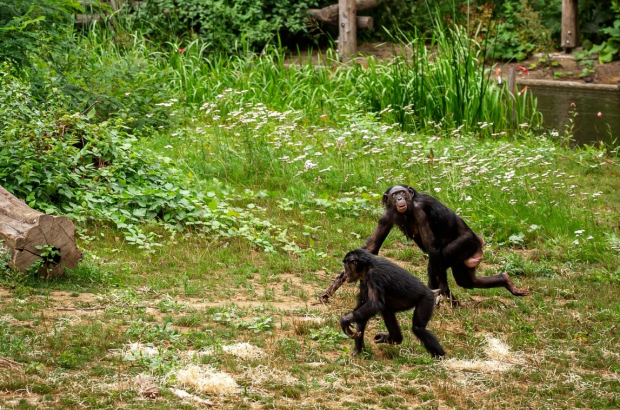- Daily & Weekly newsletters
- Buy & download The Bulletin
- Comment on our articles
Five female bonobos arrive at Antwerp Zoo
With the addition of five new members, the bonobos at the Antwerp Zoo now number 18, the second largest group of the apes in Europe. Bonobos are an incredibly active and playful species, making them a favourite attraction for zoo-goers.
They are also endangered, with between 15,000 and 50,000 left in the Democratic Republic of Congo. Encroaching development of their habitat, which is limited, and their popularity as bush meat are the main threats.
Antwerp Zoo is the co-ordinator of Europe’s breeding programme for bonobos. “The arrival of five new females brings with it a positive outlook for the future,” says Joris Jacobs of the zoo. “We hope to be able to welcome new baby bonobos at the zoo and Planckendael.”
The new members of the group at the zoo are all female: Nayembi and her daughter come from the zoo in Frankfurt, while Binti has arrived with two daughters from Cologne. The eldest of the group is Binti at 25 years, and the youngest is Binti’s daughter Balina, at nine months.
Antwerp Zoo opened a new large-scale bonobo habitat last year. It allows the animals plenty of room to explore but also to spend some time away from the group if they want. The new arrivals took to the space right away, according to the zoo.
The established members of the group are kept away from the newcomers for a time. “We don’t just throw them all together right away,” explains Jacobs. “First we let the newcomers get used to the habitat, then we allow some of the animals who rank lower in the order to become familiar with them. When they begin to clean each other, that’s a sign of a smooth integration.”

If it all goes pear shaped, like they scream, chase or bite each other, then other methods have to be considered. “It’s about respecting the pace of the animals.”
Ultimately, there will be seven families in the habitat interacting with each other. This brings the group closer to how they would behave in the wild, where bonobos live in large social groups.
The larger group also helps researchers in both Flanders and Congo to study the natural behaviour of the apes. This is more difficult to do in the wild. At Antwerp Zoo, several hidden cameras allow zookeepers and biologists to watch their behaviour and interactions closely at any time day or night.
Bonobo chimps are interesting compared to common chimpanzees for a few reasons. They tend to be matriarchal, with the females at the top of the social hierarchy. It remains to be seen if there will be any exchanges of power among the group at Antwerp Zoo.
Bonobos are also extremely social and do not split into groups among the larger community the way that common chimps often do. Males have a much greater tolerance of babies, even if the mother provides all of the care.
Finally, the species is renowned for its sexual appetite and for mating with the same sex. Sexual activity is sometimes used to greet each other, to form a social bond and even to make up after a conflict. In the wild, they have been seen to engage in communal sexual activity – bonobo orgies, if you will.
“Quarrels, friendship, and a lot of sex,” said the zoo in a statement. “Bonobos are never boring.”
Photos ©Jonas Verhulst/Antwerp Zoo



















